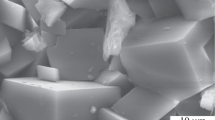Abstract—
The results of an electron-microscopy study of hydrophobic organic layers in the pore space of carbonate rocks, which change the wettability of the formation, making the rock hydrophobic, are presented. This significantly affects the technology of hydrocarbon field development. A technique for studying adsorbed layers based on morphological analysis is proposed. The data of microprobe studies of organic layers are presented, showing a higher carbon content in them compared to calcite. The results of morphological studies of the structure of samples of carbonate rocks of an oil field are shown, which make it possible to identify and study organic adsorbed layers on the surface of mineral particles formed because of the adsorption of the polar components of matrix oil. The thickness of the organic layers is determined.








Similar content being viewed by others
REFERENCES
E. Ammot, Adv. Mech. Eng. 216, 156 (1959).
E. C. Donaldson, P. B. Lorenz, and R. D. Thomas, Pet. Eng. J. 1, 13 (1969).
A. A. Zlobin and I. R. Yushkov, Vestn. Permsk. Univ., Geol., No. 3(24), 68 (2014).
Yu. S. Lipatov and L. M. Sergeeva, Polymer Adsorption (Naukova Dumka, Kiev, 1972) [in Russian].
Physical and Chemical Properties of Oil Dispersed Systems and Oil and Gas Technologies, Ed. by R. Z. Safieva and R. Z. Syunyaev (Izhevsk, 2007), p. 361.
F. G. Unger and L. N. Andreeva, Fundamental Aspects of Oil Chemistry: The Nature of Resins and Asphaltenes (Nauka, Novosibirsk, 1995) [in Russian].
R. Z. Syunyaev, R. M. Balabin, I. S. Akhatov, and J. O. Safieva, Energy Fuels 23, 1230 (2009).
B. V. Deryagin, N. V. Churaev, and F. D. Ovcharenko, Water in Dispersed Systems (Khimiya, Moscow, 1989) [in Russian].
E. J. W. Verwey and J. Th. G. Overbeek, Theory of the Stability of Lyophobic Colloids (Amsterdam: Elsevier, 1948).
N. N. Mikhailov, O. M. Ermilov, and L. S. Sechina, Dokl. Earth Sci. 466, 24 (2016). https://doi.org/10.1134/S1028334X16010232
L. Madsen and I. Lind, SPE Reservoir Eval. Eng. 1, 47 (1998). https://doi.org/10.2118/37292-PA
F. E. Bartell and J. J. Osterhof, Ind. Eng. Chem. 19, 1277 (1927).
N. N. Mikhailov, K. A. Motorova, and L. S. Sechina, Wettability of Oil and Gas Reservoir Systems: Textbook (Ross. Gos. Univ. Nefti Gaza im. I.M. Gubkina, Moscow, 2019) [in Russian].
V. A. Kuz’min, N. N. Mikhailov, N. A. Skibitskaya, and K. A. Motorova, Geol. Nefti Gaza, No. 3, 35 (2015).
N. N. Mikhailov, O. M. Ermilov, and L. S. Sechina, Aktual. Probl. Nefti Gaza, No. 1(32), 3 (2021). https://doi.org/10.29222/ipng.2078-5712.2021-32.artl
V. A. Kuz’min, N. N. Mikhailov, and N. A. Skibitskaya, J. Surf. Invest.: X-ray, Synchrotron Neutron Tech. 7, 907 (2013). https://doi.org/10.1134/S102745101305011X
A. N. Dmitrievskii, N. A. Skibitskaya, O. P. Yakovleva, V. A. Kuz’min, L. A. Zekel’, and A. A. Pribylov, Fundamental Problems of Geology and Geochemistry of Oil and Gas and Development of the Oil and Gas Complex of Russia (GEOS, Moscow, 2007), p. 360.
A. N. Dmitrievskii, N. A. Skibitskaya, and O. P. Yakovleva, in Proc. All-Russian Conf. “The Fundamentals of New Technologies in the Oil and Gas Industry: Theoretical and Applied Aspects” (GEOS, Moscow, 2007), p. 80.
M. Robin, R. Combes, and E. Rosenberg, in Proc. SPE Annu. Tech. Conf. Exhibition (Houston, 1999). https://doi.org/10.2118/56829-MS
J. Buckman, “Wettability studies of petroleum reservoir rocks,” ESEM Application Note (2000). https://doi.org/10.13140/RG.2.1.1813.2246
M. Robin, E. Rosenberg, and O. Fassi-Fihri, SPE Form. Eval. 10, 11 (1995). https://doi.org/10.2118/22596-PA
A. Ivanova, N. Mitiurev, A. Cheremisin, A. Orekhov, R. Kamyshinsky, and A. Vasiliev, Sci. Rep. 9, 10667 (2019). https://doi.org/10.1038/s41598-019-47139-y
Funding
The work was carried out within the framework of the state task on the topic “Forecast of the state of the resource base of the oil and gas complex of Russia based on systematic studies of the prospects for the oil and gas potential of natural reservoirs in carbonate, terrigenous and shale formations” (no. AAAA-A19-119030690047-6).
Author information
Authors and Affiliations
Corresponding authors
Ethics declarations
The authors declare that they have no conflicts of interest.
Additional information
Translated by M. Drozdova
Rights and permissions
About this article
Cite this article
Kuzmin, V.A., Skibitskaya, N.A. Study of Adsorbed Organic Layers in the Pore Space of Carbonate Rocks. J. Surf. Investig. 16, 640–646 (2022). https://doi.org/10.1134/S1027451022040292
Received:
Revised:
Accepted:
Published:
Issue Date:
DOI: https://doi.org/10.1134/S1027451022040292




